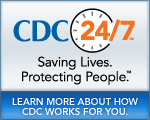MMWR – Morbidity and Mortality Weekly Report
MMWR News Synopsis for November 4, 2010
- Outbreaks Following Wild Poliovirus Importations — Europe, Asia, and Africa, January 2009a€“September 2010
- State-Specific Prevalence of Cigarette Smoking and Smokeless Tobacco Use Among Adults — United States, 2009
- Evaluation of Acute Hepatitis C Infection Surveillance — United States, 2008
There is no MMWR telebriefing scheduled for November 4, 2010.
1. Outbreaks Following Wild Poliovirus Importations — Europe, Asia, and Africa, January 2009a€“September 2010
CDC Division of News and Electronic Media
(404) 639-3286
Polio-free areas remain at risk of wild poliovirus (WPV) importation from the reservoir countries until transmission is interrupted everywhere. While all 2009 importation-related WPV outbreaks but one appear to have been interrupted, new importations have occurred in 2010, including the first WPV importation into the World Health Organization European Region since the region was certified polio-free in 2002, which resulted in a large-scale outbreak in Tajikistan (458 cases), with 18 more cases in Kazakhstan, Russia, and Turkmenistan. All polio-free countries are advised to maintain high vaccination coverage and sensitive surveillance systems at all times. Should WPV importation be recognized, health authorities need to rapidly institute supplementary immunization activities to limit WPV spread and interrupt outbreaks so that Global Polio Eradication is achieved.
2. State-Specific Prevalence of Cigarette Smoking and Smokeless Tobacco Use Among Adults — United States, 2009
CDC Office on Smoking & Health
(770) 488-5493
Smokers who also use smokeless tobacco may be less likely to quit tobacco use altogether. The safest course of action for smokers is to quit smoking altogether, not to substitute one tobacco product for another. To assess current cigarette smoking and smokeless tobacco use among adults, CDC analyzed data from the 2009 Behavioral Risk Factor Surveillance System (BRFSS). The report indicates wide variation in self-reported cigarette smoking prevalence and smokeless tobacco use across all 50 states, the District of Columbia (DC), the U.S. Virgin Islands, Puerto Rico, and Guam. In addition, the report provides data on the percentage of adult cigarette smokers who also use smokeless tobacco. Smoking among U.S. states and territories ranged from 6.4 percent (U.S. Virgin Islands) to 25.6 percent (Kentucky and West Virginia); smokeless tobacco use ranged from 0.8 percent (U.S. Virgin Islands) to 9.1 percent (Wyoming); and the percent of smokers who also use smokeless tobacco ranged from 0.9 percent (Puerto Rico) to 13.7 percent (Wyoming). Smokeless tobacco use is predominantly a problem among men, young adults, those with a high school education or less, and in some states with higher smoking prevalence.
3. Evaluation of Acute Hepatitis C Infection Surveillance — United States, 2008
National Center for HIV/AIDS, Viral Hepatitis, STD, and TB Prevention
News Media Line
(404) 639-8895
A CDC analysis finds that supporting enhanced acute hepatitis C (HCV) surveillance can improve completeness and timeliness of case reporting, providing a greater benefit to public health. Researchers compared data on acute HCV cases reported in 2008 from the National Notifiable Diseases Surveillance System, CDC's nationwide system for disease reporting, with data collected through enhanced surveillance efforts in selected states participating in the Emerging Infections Program (EIP), a network of health departments funded by CDC to provide detailed surveillance data that can be used to improve public health responses to emerging infectious diseases. Overall, EIP sites reported more acute HCV cases than were reported in routine national surveillance, did so sooner after diagnosis, and collected more complete information on race, clinical symptoms, and major HCV risk factors. Enhanced HCV surveillance is critical to public health efforts because accurate and timely data are needed to detect and control outbreaks, guide and evaluate prevention strategies, and to initiate treatment early among those who are infected (thereby preventing advanced liver disease and decreasing healthcare costs). The authors note additional resources for hepatitis surveillance, such as those recently called for by the Institute of Medicine, could further improve these vital public health activities.
- Historical Document: November 4, 2010
- Content source: Office of the Associate Director for Communication, Division of News and Electronic Media
- Notice: Linking to a non-federal site does not constitute an endorsement by HHS, CDC or any of its employees of the sponsors or the information and products presented on the site.
View Press Releases in
Get e-mail updates
To receive e-mail updates about this page, enter your
e-mail address:
Contact Us:
- Centers for Disease Control and Prevention
1600 Clifton Rd
Atlanta, GA 30333 - 800-CDC-INFO
(800-232-4636)
TTY: (888) 232-6348 - Contact CDC-INFO


